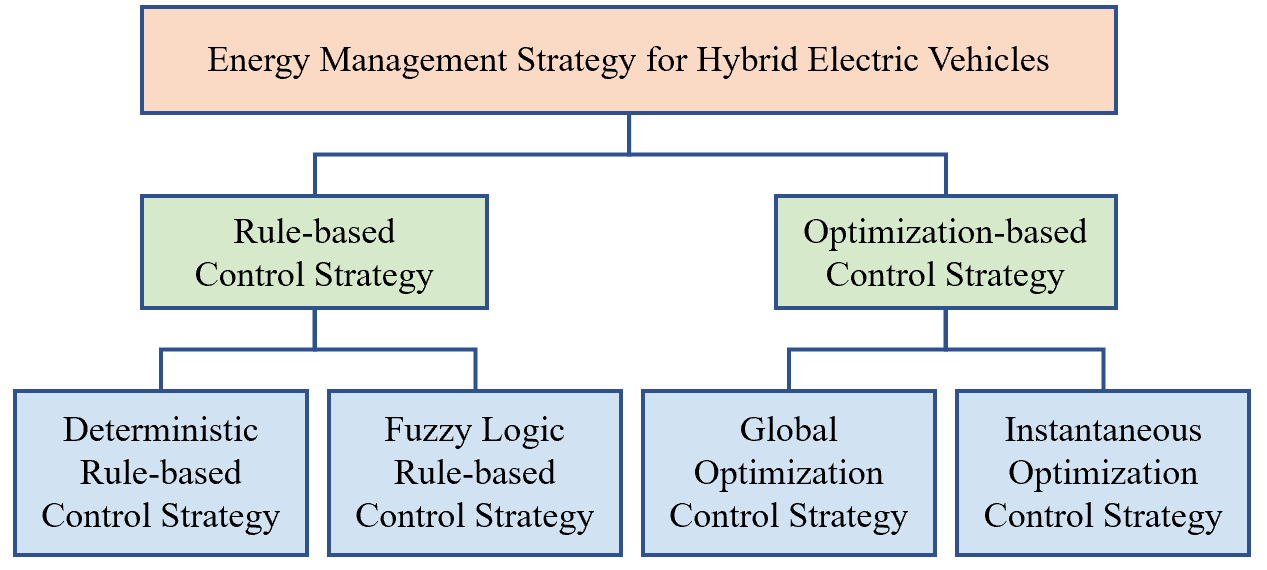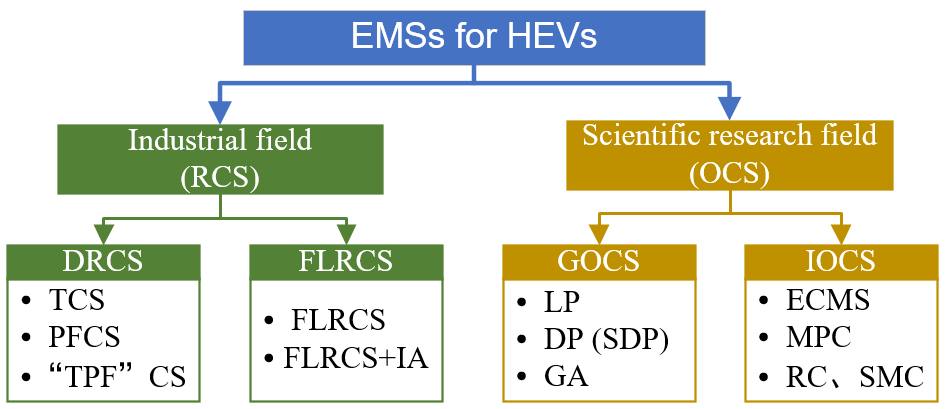A Comprehensive Review on Classification, Energy Management Strategy, and Control Algorithm for Hybrid Electric Vehicles
- hybrid electric vehicles
- energy management strategy
- algorithm
- optimization
- classification
1. Definition
The vehicle industry is experiencing a technological revolution in the powertrains of vehicles. A hybrid electric vehicle (HEV) is an effective choice to solve the problems of the low energy density of a power battery and the short driving distance of an electric vehicle (EV). Different configurations of HEVs have different control strategies, production costs, and applicable conditions. However, for any configuration, the ultimate goal is to achieve the comprehensive optimization of the efficiency of the engine and the motor so as to improve the vehicle’s performance parameters such as economy, emissions, and durability. The procedure of realizing the goal is commonly called an energy management strategy (EMS).
2. Classification of EMS for HEV
The EMS has always been a key research topic in the field of HEVs, and its strategies and control algorithms emerge endlessly [1]. At present, the EMSs of HEVs can be classified according to the topological structure shown in Figure 1 that can be divided into two categories: the RCS and the optimization-based control strategy (OCS).

The EMS of an HEV is the basis for a good performance of the vehicle. The core problem is to determine the working mode of the powertrain under various driving conditions, as well as the power distribution between the engine and the motor in each working mode.
It is worth mentioning that the EMS of an HEV should not only solve the problem of energy distribution of each power source—it should also consider the problem of braking energy recovery. Regenerative braking of is one of the main HEV technologies used to improve their economy. During the driving process of an HEV, braking energy recovery is an important function that increases the driving range and affects the fuel economy of the vehicle. HEVs have different configurations and corresponding EMSs. For a certain configuration, it is necessary to study the matching EMS to make full use of its advantages.
3. Comparison of Control Strategies and Algorithms
3.1. Comparison Based on Characteristics
In order to facilitate comparative analysis, the characteristics of different EMSs are summarized in Table 1.
Table 1. Characteristics of energy management strategies
3.2. Comparison Based on Practicability
In recent years, many scholars have done extensive research on the EMSs of HEVs. Among them, RCSs and OCSs are the current research hotspots [2][3]. IAs have huge advantages by combining these two strategies. Based on the objective conditions of the development of engineering technology and theoretical research, most of the control strategies and algorithms have not been applied in industry and are still in the stage of scientific research. A classification and comparison of EMSs and control algorithms for HEVs based on practicability are shown in Figure 2.
Figure 2. Classification based on practicability.
3.3. Comparison Based on Development and Evolution
Based on DRCSs, OCSs, and ICSs, the development history of EMSs for HEVs is summarized in Figure 3. In order to improve the comprehensive performance of the hybrid power system, the advantages of various EMSs are synthesized to realize compound control. The EMS of intelligent optimal control, which effectively combines the optimization algorithm and intelligent control method, is an effective way to solve the energy management problems [4] of HEVs and is an important research direction at present.
Figure 3. Classification based on development and evolution.
4. Prospect
Considering the current problems in the EMSs of HEVs and the development trend in this field, future research directions include:
(1) By integrating a variety of methods to complement each other, there are many EMSs for HEVs, and each strategy has its own characteristics. Different control strategies have different limitations in the energy management problems of HEVs. How to integrate different methods, learn from each other, and realize the approximate GOCS that can be applied online are the research focuses of the energy management of HEVs.
(2) Generally, the existing EMSs only consider fuel economy, and there have been few comprehensive studies on economy, emission, battery life, and driving style. The ultimate goal of study is to propose an EMS that considers and coordinates energy saving, environmental protection, cost, and driving style.
(3) Intelligent and optimized EMSs are an effective way to solve the energy management problems of HEVs, and the organic combination of intelligently optimized control methods and prediction technologies for driving conditions is an important research direction in the future.
This entry is adapted from the peer-reviewed paper 10.3390/en13205355
References
- Benmouna, A.; Becherif, M.; Depernet, D.; Mohamed, A.E. Novel energy management technique for hybrid electric vehicle via interconnection and damping assignment passivity based control. Renew. Energy 2018, 119, 116–128.
- Sabri, M.F.M.; Danapalasingam, K.A.; Rahmat, M.F. A review on hybrid electric vehicles architecture and energy management strategies. Renew. Sustain. Energy Rev. 2016, 53, 1433–1442.
- Tie, S.F.; Tan, C.W. A review of energy sources and energy management system in electric vehicles. Renew. Sustain. Energy Rev. 2013, 20, 82–102.
- Larsson, V.; Johannesson, L.; Egardt, B. Cubic spline approximations of the dynamic programming cost-to-go in HEV energy management problems. In Proceedings of the 2014 European Control. Conference, Strasbourg, France, 24–27 June 2014; pp. 1699–1704.



